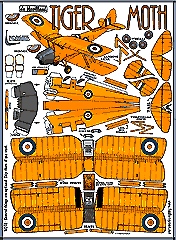
Tiger Moth - $$4.95
The de Havilland DH 82 Tiger Moth is a 1930s biplane designed by Geoffrey de Havilland and was operated by the Royal Air Force and others as a primary trainer≥ By start of the Second World War, the RAF had 500 of the aircraft in service and large numbers of civilian Tiger Moths were impressed to meet the demand for trainers.
The De Havilland Tiger Moth, British & Canadian Trainer
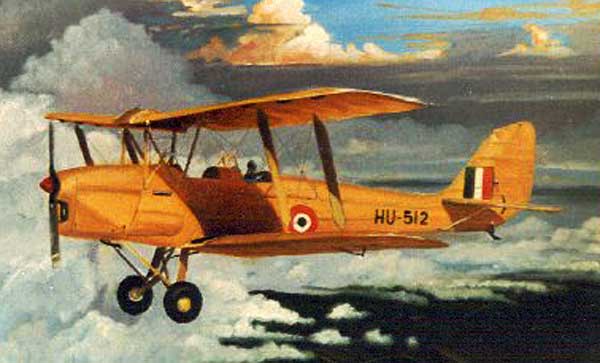
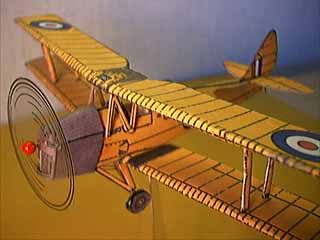
This little Commonwealth gem trained many future pilots with style. Our model has a few 'optional' items like seats, instrument panels, and even a retractable shroud for instrument instruction. Wheels have Cheerios for spacers, and toothpicks strengthen the wing and landing gear struts.
de Havilland Tiger Moth
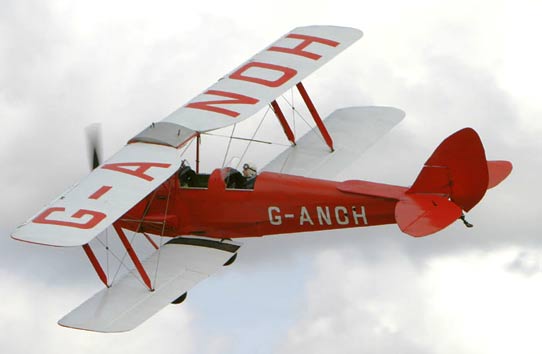
As a young man of twenty-seven, Geoffrey de Havilland had a good job with a firm of automobile engineers. Reputable automobile engineers, the record is careful to state, a rare institution then and not a common one now. Forty five shillings a week, he made-say, $11-almost a fortune, but it was not enough for de Havilland, who burned with the dream of building his own airplane. He knew nothing of aerodynamics and little of structures, but in those days few people did. Young de Havilland had a grandfather who must have had a stronger faith in the inheritability of talent than most grandfathers, for he lent his young grandson £500 for his project. De Havilland resigned his job, found a room that was spare near Bedford Square, took on his friend Frank Hearle as assistant, and was in business.
The plane the two lads built followed the classic layout of the Wright brothers:biplane wings, twin pusher propellers, a forward elevator, and arear rudder. By midwinter it was ready. For taxiing tests they chose a site on Salisbury Plain, every bit as windy and as shivery as the Wright's own Kitty Hawk, and they huddled over a coke-burning brazier to fight the chill. The tests began; on one, feeling himself almost airborne, de Havilland heaved back on the elevator, bounced briefly into the air, and then collapsed in a tangle of white pine and oiled silk. It was the end of the D.H. 1. De Havilland, as if to reassure the little knot of spectators already running toward the wreckage, but perhaps more to convince himself he was still breathing, thrust an arm up from the jumbled wreckage, only to collect a sound clout on the wrist from the still whirling propeller- fortunately his only injury.
No job, no money, no airplane, and one arm in a sling: what next? It seems de Havilland must have enjoyed tempting providence, for at this juncture in his life he chose to get
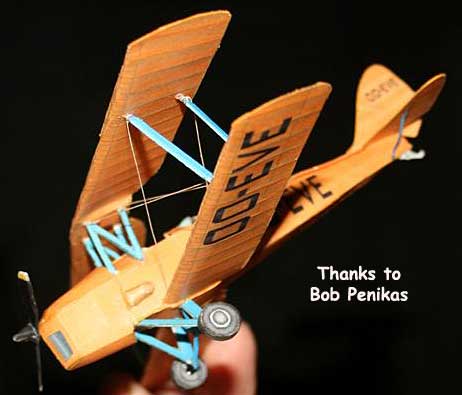 Hi folks, Just showin' off my mother's day gift for Grandma Eve. This is a DeHavilland Tigermoth model from the Guido Van Roy versions with the letters EVE. Six and a half inch (6.5) wingspan.. Bob Penikas |
|---|
married. Once more that splendid grandparent came to his aid. Announcing that he had intended leaving Geoffrey another £500 anyway, he said the lad might as well have it now. When the war came, de Havilland was briefly with the Royal Flying Corps, then was seconded to the Aircraft Manufacturing Co., just north of London, again as designer. Here he toiled for the duration of hostilities, with no mean success, for his designs flew strongly (when the engines allowed) and were built in enormous numbers. Even the U. S. Army Air Corps flew de Havillands. Almost five thousand D.H. 4's were built under license in the United States.
By war's end, de Havilland had made his name with the public and was able to raise £20,000 to start his own company. Not much work came along at first, but one wealthy sportsman ordered a large private touring airplane, and when it was delivered casually inquired if de Havilland would like any additional financing. He would, and with it he bought the aerodrome at Stag Lane, where his factory was.
In 1923 the famous Lympne trials were organized by the Air Ministry to encourage the development of light airplanes suitable for private ownership. De Havilland came up with a tiny low-wing monoplane, a single seater powered by a two-cylinder motorcycle engine, named the D.H. 53 Hummingbird. The Air Ministry ordered a few for the RAF, and one was used in experiments in air-launching small airplanes from a dirigible. One RAF test pilot evolved what he felt was a splendid game with the D.H. 53. He would cruise the wide open spaces of Salisbury Plain till he found a motorcyclist on a lonely road. He then descended till he was flying just behind the cyclist, who hearing the motorcycle engine in his ear would think it was another motorcyclist seeking to overtake and would wave the pilot on. At which the RAF man opened the throttle and sailed right on by.
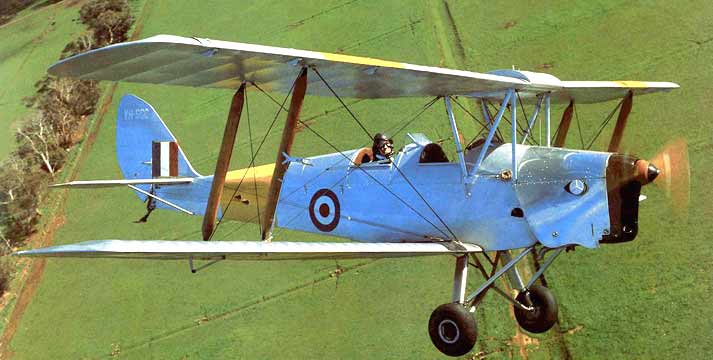
The Lympne trials had been based on the erroneous premise that a successful light airplane, when it was achieved, would be as low-powered as the automobiles of its day, and entries had been limited to power plants of no more than 1,150 cc, which meant flew at all, let alone was a rotten airplane, and the final indignity was when, in completing a demonstration flight across the English Channel, one was overtaken by a Belgian goods train of the slowest kind. In retrospect, it was a lucky thing that the D.H. 53 was so poor, for it set de Havilland thinking that this ultra light approach to aviation for everyman was unsound. His next design was the D.H. 51, which employed a 90-hp war-surplus engine that de Havilland bought in bulk for less than a pound each, but there were grave certification problems with this engine, so de Havilland went to a big 120-hp power plant built by his old wartime employers, and which was licensed. But it was far too expensive. So he thought again.
Engine problems had plagued his work throughout the war. Engines were never available when promised and couldn't be relied on to work when they were eventually delivered. One of the few good ones had been the Air disco in his D.H. 5 l's, a V-8 developed from a French Renault engine by de Havilland's friend Frank Halford. Halford was now following the uncertain profession of free-lance engine designer, so de Havilland stripped down an Air disco and invited Halford to look at it. Could he make a four-cylinder engine of 60-hp out of one bank of the Air disco's eight cylinders? The idea must have seemed somewhat harebrained to Halford, whose mind was in any case busy on a new engine for Aston Martin cars, but he reluctantly agreed to try. They would use Air disco (Renault) pistons, cylinders, and valves in a new crankcase, with automotive carburetors and magnetos to keep costs down. It was a wispy, tenuous kind of beginning, so they called the new engine the Cirrus.
With a suitable engine on its way, on the design of D.H. 60. For
all the de Havilland, a glutton for work, started greatness it
was to achieve, the D.H. 60 was in appearance just another de
Havilland biplane, deriving from a pattern that went back to D.H.
4. It had straight, squarish wings set one above the other, wood-strutted
and wire braced, and attached to an all-wooden fuselage of simple
square section with a curved top decking. The fin and rudder were
shaped by two curves coming to a point, a feature that was to
mark just about every de Havilland airplane until they began to
enter the transonic speed range in the late 1940's. D.H. 60 boasted
an airfoil-shaped fuel tank (capacity fifteen imperial gallons)
amidships on the top wing, and an undercarriage that used rubber
in compression, rather than the then-usual arrangement of stretched
rubber cords. The two occupants sat in open cockpits, one behind
the other. Almost the only novelty in No. 60's design was the
ailerons. Captain de Havilland's patent ailerons were an attempt,
only partly successful, to eliminate adverse yaw by limiting the
travel of the down going aileron. Unfortunately, the down going
aileron not only provides most of the yaw, but much of the roll
movement, too, and the Captain's patent ailerons have a sloppy
feel that has endured. This lack of aileron effectiveness was
not helped by their installation on the lower wing only.
Captain de Havilland had other interests than aviation, and one of them was insects, notably butterflies and moths. Moths, or most of them, fold their wings back along their bodies when at rest, and de Havilland arranged for his pH. 60 to do the same, so you could tow it on the road behind a car, and keep it in an ordinary garage. All the DH 60 then lacked was the dignity of a name. But surely there was one ready-made! The Moth.
The Captain made the Moth's first flight on February 22, 1925, and even he seems to have been surprised at how nicely it flew. As was a remarkable gentleman, Sir Sefton Brancker, not long after. Sir Sefton was director of Civil Aviation, and he took the powerful step of starting five government-sponsored flying clubs and ordering a grand total of ninety Moths to equip them. It was the beginning of private flying on any appreciable scale in Britain or, indeed, the world. (The Taylor/Piper Cub was still ten years in the future.)
The prototype Moth had (I think) a blue-painted fuselage and
clear-doped, gauzy, dragonfly-like wings, and so did the first
few turned out thereafter, but soon silver was adopted as the
standard finish, Moth-silver being a kind of British parallel
to Cub-yellow. The exhaust pipe, which ran along the left side
of the cockpit and burned your left wrist if you weren't careful,
was moved to the right side-I know not why-where it burned your
right wrist. A little of the vertical fin was taken away and given
to the rudder to lighten the load on your feet, and the luggage
locker was moved to behi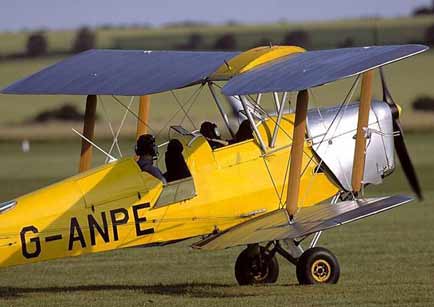 nd the rear cockpit, and that was all.
The Moth was now perfect.
nd the rear cockpit, and that was all.
The Moth was now perfect.
Its performance might seem modest enough by today's
standards, but for a private airplane in the 1920's it was progress.
The Cirrus Moth cruised at about 80 mph, with a rate of climb
of maybe 500 feet per minute, and a fuel consumption of four and
a half gallons per hour. All this was a giant step forward from
the pitiful fluttering's of the ultra light airplanes of the Lympne
trials. The Moth in flight was very quiet and not uncomfortable,
and the purchase price of £830, while far from being within
the reach of all, was certainly within the reach of many. You
could operate a Moth for under a pound an hour, and this modest
expenditure, further reduced by the Government's generous and
enlightened subsidies to the flying clubs, made flying intensely
popular in no time at all. The Moth was an extremely practical
airplane and, more important, it was quite reliable.
Its development continued steadily. Soon there was the Cirrus II Moth with the engine lowered an inch or two to improve the pilot's rotten forward view; and the Genet Moth, with a rather uncertain 75-hp radial engine of that name; and the Hermes Moth, with a new kind of Cirrus up rated to a tremendous, breathtaking 105 horsepower.
But soon there came a problem. Owing to the Moth's very success, the supply of war surplus Air disco engines and, therefore, of the Cirruses that were made from them began to dwindle. Further, the company making the conversions found the work not notably profitable and began to lose interest. The Cirrus was a cornerstone of the Moth's success; what was Captain de Havilland to do? Nothing for it but to make his own engine, with Halford's help.
Although General Motors might disagree, one of the quickest ways to develop an engine, both mechanically and in the public's eye, is through racing, and this was the101route de Havilland chose to follow. After his racing engine had established itself, while putting out some 135 hp, he planned to manufacture it in a form derated to nearer 100 hp. A racing airplane would be needed. Quickly de Havilland came up with D.H. 71, named Tiger Moth, but no relation to our later heroine of the same name. Two D.H. 71's were built in the traditional great secrecy. They were low-wing monoplanes of the sleekest lines designed to have the smallest possible cross section that could enclose de Havilland's test pilot Hubert Broad, who fortunately was fairly narrow.
Halford's new engine was a pippin. For its 135-hp output it weighed, at three hundred pounds, only fourteen pounds more than the old Cirrus. The handling of the D.H. 71 kept Hubert Broad busy, and it was not a notable racing success, although one did capture a world speed record in its weight class at 186.47 mph. And it did prove out the new engine. De Havilland chose for the new powerplant the name Gipsy, and the airplane thus powered became the Gipsy Moth.
With the 100-mph Gipsy Moth, the high tide of success for de Havilland began to be a flood. His company, which in 1924 employed but a few hundred people and was capitalized at under £49,000, grew by 1930 to a business worth almost half a million pounds and employing fifteen hundred people. Production rose from less than one airplane a week to better than three a day. The Moth was making de Havilland rich, and he was able to reduce the machine's price progressively. By 1929 it was down to a mere £650. Eighty-five out of a hundred private airplanes in Great Britain were Moths of one persuasion or another. When His Royal Highness the Prince of Wales (now the Duke of Windsor) purchased one, a Moth became absolutely the thing to have, and the society glossies were full of pictures of Sporting Characters and Bright Young Lady Pilots setting off for weekends in the country in their 103 Moths. Any kind of private airplane in England became, in general parlance, "a Moth," in the same way that, later in the decade, any small airplane in America was "a Cub."
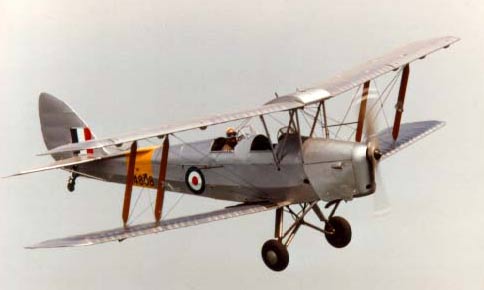
The things people did in their Tiger Moths!
In the United States the
fair and intrepid Laura Ingalls looped a Moth 344 times in succession
to set some dubious kind of record. People flew all over the world
in them. But surely the boldest Moth adventurer of all was Francis
Chichester, in whose life the Gipsy Moth has played a big part.
A native Englishman who proved troublesome in his youth, Chichester
was shipped off to the Dominions, New Zealand to be exact, where
in quite a short time he made a small fortune in the timber business.
Returning to England, his pockets jingling, he took flying lessons
and, once he had a license, bought a Moth. After a shakedown cruise
around Europe, but still with less than a hundred hours of flying
time, he set off on a solo flight for Australia. At this date
(1929) only one other pilot had ever flown solo to Australia.
Chichester made it after some terrifying adventures, which so
little daunted him he next set off to be first across the Tasman
Sea that separates Australia from New Zealand. For this adventure
his Moth was set on floats, and Chichester had to devise a new
technique of astronavigation to find the two tiny islands which
were to be his stepping-stones. In the lagoon at one of them his
Moth sank, but he fished it up and over the course of a year or
so rebuilt it, unaided by professional hands. It was his intention
to continue on around the world. He got as far as Japan, where
a wire stretched between two hilltops plucked his Moth from the
skies and almost sent Chichester to his grave. For his recent
circumnavigation of the world he chose a sailing boat, but was
faithful enough to his earlier love to christen her Gipsy Moth
III. She was met, sailing into Plymouth Harbor at the end of her
fantastic voyage in 1968, by a Gipsy Moth airplane, flying low
over the waves. One wonders how Sir Francis felt at the sight.
Where Chichester had led, others followed. In 1930 an ex-secretary named Amy Johnson flew another Gipsy Moth to Australia. Her airplane, registered G-AAAH and named Jason, is to this day hanging from the ceiling of the National Aeronautical Collection in London. By the end of 1930 nearly two thousand Moths had been sold and delivered. The success of the species was such that de Havilland was to some extent hoist with his own petard, and obliged to call everything he designed a Moth. There was the Giant Moth (more of a Giant Myth really), a big 500-hp biplane transport seating eight in a cabin pins the chauffeur in a breezy cockpit behind them; the Hawk Moth, a high-wing monoplane intended for air taxi work and superficially resembling Lindbergh's immortal Ryan; and a host of others.
It was soon time to develop the Gipsy Moth further. The first
improvement had been a welded steel-tube fuselage variant, the
Metal Moth, manufactured side-by-side with the spruce and three-ply
structure. Then came wider let-down cockpit doors and a luggage
locker enlarged to hold a set of golf clubs, for the Moth could
land and take off easily from almost any fairway. An enclosed
coupe top was a popular option on Moths going to Camida. So equipped,
one flew the first air mail into Newfoundland. The Gipsy Two
engine, pulling 120 hp, came along, and so did a strengthened
Metal Moth called the Moth Trainer, intended to whet the interest
of the military. The area most needing improvement in Moth design-forward
visibility-remained. Just where you wanted to look, while taxiing
and during the short takeoff run, and especially on landing, the
sky was filled with the Gipsy's cylinders and clattering valve
gear. Nor could the engine be lowered without bringing the propeller
tips too near the groun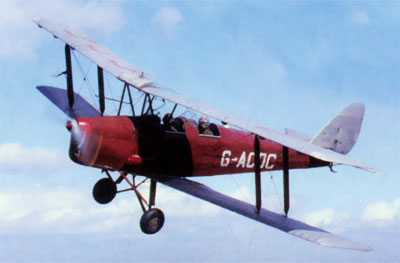 d. The solution was to invert the engine,
and this was done in 1930 with the engine called Gipsy Three,
which first powered a new high-wing monoplane, D.H. 80, soon named
the Puss Moth. Upped to 130-hp output, the Gipsy later became
the Gipsy Major, and the Metal Moth, powered by it, became the
Moth Major.
d. The solution was to invert the engine,
and this was done in 1930 with the engine called Gipsy Three,
which first powered a new high-wing monoplane, D.H. 80, soon named
the Puss Moth. Upped to 130-hp output, the Gipsy later became
the Gipsy Major, and the Metal Moth, powered by it, became the
Moth Major.
The Tiger Moth, the most massively successful Moth of all, came about because the Royal Air Force, while nibbling at the Moth Trainer, was unhappy about the poor accessibility of the front cockpit. Service crews all wore parachutes as a matter of course, and getting into or out of the front, or instructor's, cockpit of a Moth meant clambering under the top wing and through the cat's cradle .of supporting struts and wires. Difficult enough on the ground while you were wearing a parachute, but quite impracticable if you had to bail out quickly in the air. Could de Havilland do something about this? De Havilland, with prospects of a big RAF order in mind, found that he could. No abstruse calculations in a design office took place, though. Instead, a Moth was dismantled in a small shed and jury-rigged as needed. The top wing was moved forward eighteen inches, then four inches more. Fine, you could get in and out of the front cockpit even with a chute strapped to your bottom. But the center of gravity was now behind the center of pressure. So all four wings were swept back nine inches at the inter plane struts, the rear spars were shortened, and new struts fitted. Pencils flew furiously across the backs of old envelopes. Still not quite enough was the verdict, and so the upper wings were angled back an additional two inches. That was it.
After the first few Tiger Moths had flown (the name was borrowed from the earlier D.H. 70 racing airplane), it was found that this sweep back had brought the lower wing tips too near the ground, and so to raise them the inter plane struts were shortened. Which explains why to this day the lower wings of a Moth have more dihedral than the upper pair.Thus cut and fitted, an already sweet-handling design was rendered sweeter, for the increased dihedral and wing sweep added to the Moth's lateral stability, as well as vastly improving the pilot's view.
The excellent inverted Gipsy was installed in other designs, as well: the Leopard Moth (which had a sad history of structural failures), the Fox Moth, the Hornet Moth, the twin-engine Dragon, and so on. (There never was a small aero engine as reliable as the Gipsy Major. Certainly it is more so than the modern fiat opposed power plants.)
The RAF's order for a new basic trainer would be large, and de Havillands had plenty of competition from such now-forgotten machines as the Blackburn Bluebird and B.2, the Avro Cadet and Tutor, the Robinson Redwing, and the Hawker Tomtit. Trials were held, supported by a great deal of advertising from the competing manufacturers in the aviation press, at the Aeroplane and Armament Experimental Establishment at Martlesham Heath. Thirty-five D.H. 82 Tiger Moths were ordered as a result. In retrospect it seems that one point in the Tiger's favor was that it was not so easy to fly as some of its competitors, and in truth it does a creditable job in magnifying many kinds of sloppiness in piloting technique without allowing them to become dangerous. The airplane had and still has some obvious faults. "The shaking and juddering while ticking over," one RAF instructor noted, "the dreadful aileron control, the effort required to put up an inverted formation at the Hendon Display, the difficulty in operating in any sort of wind; no brakes and the tail skid tearing up great chunks of grass field!" He might also have commented on the extraordinary draftiness of the cockpits, but being no doubt a rugged, outdoors Englishman he probably didn't even notice.
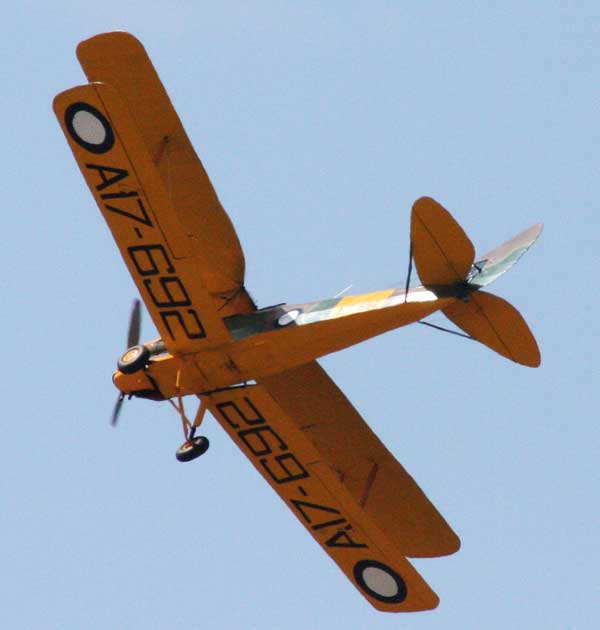
The clubs wanted Tiger Moths, too, but most of them had to wait until 1937, such was the rush of service and export orders. One exception was Sir Alan Cobbam's National Aviation Days air circus. In 1926, Cobham had flown to Australia and back in a D.H. 50 floatplane, landing on the River Thames alongside the Houses of Parliament to receive his hard earned knighthood. (He was also the D.H. 53 pilot who was overtaken by the train.) De Havilland saw that he got two Tiger Moths for his circus fleet, modified, like several of the RAF's machines, so the engine would run throughout inverted aerobatics. One of Cobham's circus pilots, C. Turner-Hughes, kept records of his days with the show, and recorded 788 hours on the Tiger Moths, including 2,328 loops, 2,190 rolls, 567 bunts (forward loops), 522 upward rolls, 40 inverted falling leaves, and 5 inverted loops. He survives to this day, hale and hearty, proof that aerobatics are good for you. His successor, Geoffrey Tyson, flew inverted all the way across the English Channel on the twenty-fifth anniversary of Bl6riot's first crossing, and became the hero of the hour. Like Turner-Hughes, he went on to become a test pilot, never losing his aerobatic skill, as those who watched his eerie demonstrations in the huge 140-ton Princess flying boats at Farnborough during the fifties will well remember.
The Tiger Moth had entered what might be called its Middle Period, the era of its mass production. Almost nine thousand were built in all, and from the mid-thirties till long after the end of the war there can hardly have been a British or Commonwealth pilot, military or civil, who was not trained, at least in part, on the type. The peaceful Tiger even came close to going to war, when plans were made to fit it with small bomb racks, and when a small unit of them sought German submarines around the Scottish Islands, its pilots mercilessly frozen by sea spray and tormented by droppings from the carrier-pigeon communications system in the front cockpit. (One Tiger did, in fact, find a submarine and manage with Very lights to summon Royal Navy units which sank it.)
The clubs, the very British flying clubs, were revived soon after the war and equipped with Tiger Moths. I was taught to fly at the West London Aero Club in 1952 on Tiger Moths, my instructor a mere slip of a girl pilot who needed a heap of cushions to see over the Tiger's coaming, and was only occasionally exasperated by my ineptness at the controls. You talked, as ever in most Moths, at full bellow through tubes connected to earphones, a system called Gosport Tubes, only one degree more effective than telepathy, but I can still hear her pretty girlish voice, distorted like distant bath water, gurgling to me: 'No, no, no, Gilbert. Like THIS." Yet somehow I learned, and went on to win an aerobatic contest for Tiger Moths, the Esso Voltige Trophy, twelve years later. She would have been proud of me, and not a little amazed.
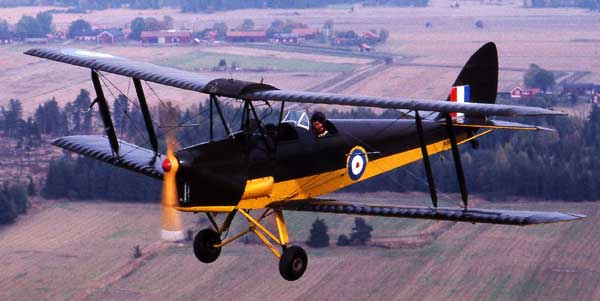
In its old age the Tiger turned adventurous once more and inspired its own club, the Tiger Club, sponsored by a wealthy paper manufacturer named Norman Jones, who raced in Tigers whenever possible and revived Cobham's old air circus idea with tremendous success. The Tiger Club also developed the Super Tiger, a much modified lightweight aerobatic special with a more powerful brand of Gipsy engine, smoke systems, inverted fuel supply, and fuel tank moved from mid wing to where the front cockpit had been. But the Tiger's flat bottomed airfoil was against it. The Super Tiger was unhappy on its back, and no match in contests for the continental aces in their Stampes and Jungmeisters. The first Super Tiger was named the Bishop, for that was the name of the club's instructor; the next two the Deacon and the Archbishop.
Fervently one hoped for a fourth to be called the Actress, for obvious if disreputable reasons, but it never happened. But on the fiftieth anniversary of M. Bleriot's journey, one of the club's aces did once more fly the Bishop across the Channel inverted (only to kill himself practicing inverted flight a year or two later). Generally, however, the old Tiger is a good choice of mount if you're going to have a prang, as the Tiger Club more than once found out. They've pranged a few, often to the rich emotional satisfaction of an interested crowd at an air show. But usually with less tragic results. The Sutton harness holds you firm in your seat, and there's a deal of matchwood to be made of the structure before the solid earth can smite you. In one London newspaper's files there is an insane photograph of Lewis Benjamin in a Deacon, absolutely vertical, a foot above the grass, after an unwonted spin. His pride was hurt and so was his nose, but that was all. The Deacon was indisposed for longer.
The Super Tiger is draftier than ever, and even more helpless than a standard Moth when taxiing on a windy day. But she does do the most beautiful hammerhead stalls of any type of airplane in the world, and is also an excellent glider tug. But the ailerons are still, after thirty-five years, dreadful; no other word is appropriate to describe them.
Maybe five hundred Moths of all sorts still fly, mostly in England and Commonwealth countries. De Havilland's name was buried with some haste by the Midland combine that took over his company and would have you talk of the Hawker Siddeley Tiger Moth (though no one does). The Tiger Moth has lately gained an FAA-type certificate, and several are proudly flown by collectors on a standard certificate of airworthiness, while the handful of Cirrus and Gipsy Moths qualify as antiques. Most of the Tiger Moths flying in the U.S. or Canada are the Canadian-built variant with a canopy, brakes, and a tail wheel, for you cannot just get out and push and heave away throughout the North American winter without real suffering. Whatever the type of Moth, if you get the chance to ride in one, take it. This was the machine that taught Winston Churchill's famous Few to fly, not to mention the hordes that came after them. A great airplane. So, after the honeymoon, de Havilland started on airplane No. 2. This time it flew properly and caught the attention of the British government, which bought it for £400 and hired de Havilland as an aircraft designer to work at the Royal Aircraft Factory. Just like that, for the Great War was coming on and aircraft designers were scarce. Aircraft designers who had built airplanes that actually flew were very scarce indeed.
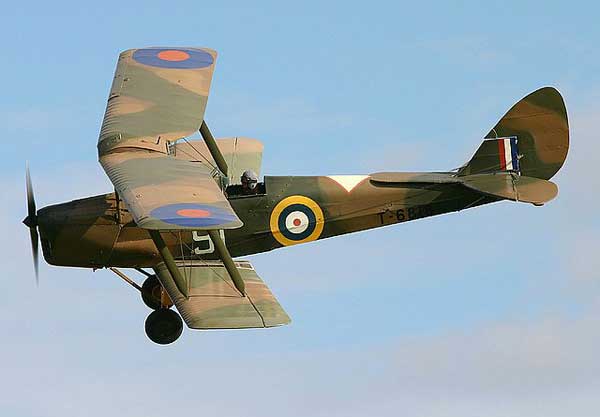
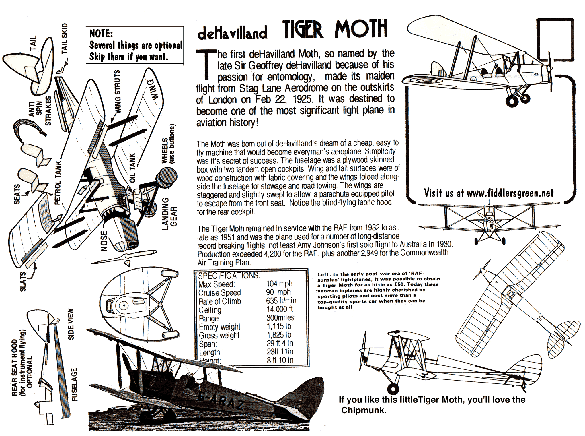
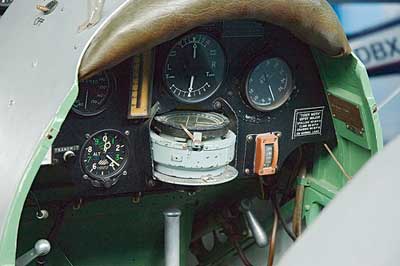 |
The de Havilland Tiger Moth rear cockpit. |
Specifications
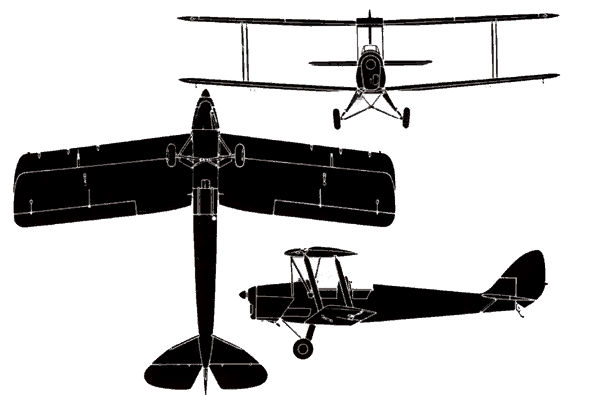 |
Crew: 2, student & instructor Length: 23 ft 11 in Wingspan: 29 ft 4 in Height: 8 ft 9 in Wing area: 239 ft² Empty weight: 1,115 lb Loaded weight: 1,825 lb Powerplant: 1× de Havilland Gipsy Major I inverted 4-cylinder inline, 130 hp Performance Maximum speed: 109 mph at 1,000 ft Range: 302 miles Service ceiling: 13,600 ft Rate of climb: 673 ft/min |
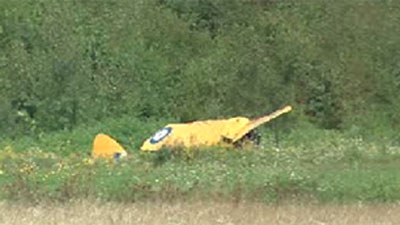 |
Howard Cook was performing a training exercise in a de Havilland Tiger Moth on Friday, August 28, 2009 when he crashed just short of the runway at the Gatineau airport.
|


